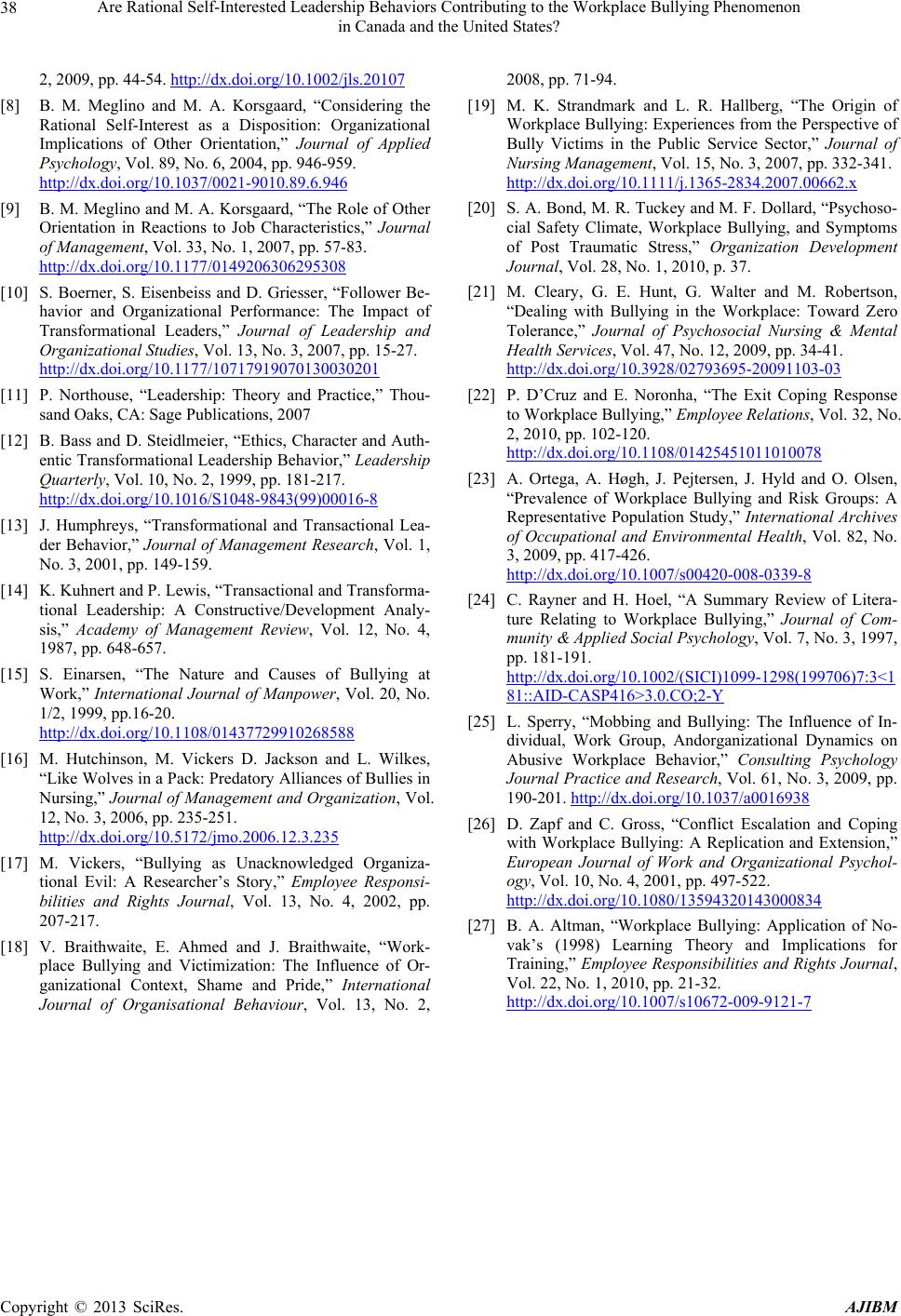
Are Rational Self-Interested Leadership Behaviors Contributing to the Workplace Bullying Phenomenon
in Canada and the United States?
Copyright © 2013 SciRes. AJIBM
38
2, 2009, pp. 44-54. http://dx.doi.org/10.1002/jls.20107
[8] B. M. Meglino and M. A. Korsgaard, “Considering the
Rational Self-Interest as a Disposition: Organizational
Implications of Other Orientation,” Journal of Applied
Psychology, Vol. 89, No. 6, 2004, pp. 946-959.
http://dx.doi.org/10.1037/0021-9010.89.6.946
[9] B. M. Meglino and M. A. Korsgaard, “The Role of Other
Orientation in Reactions to Job Characteristics,” Journal
of Management, Vol. 33, No. 1, 2007, pp. 57-83.
http://dx.doi.org/10.1177/0149206306295308
[10] S. Boerner, S. Eisenbeiss and D. Griesser, “Follower Be-
havior and Organizational Performance: The Impact of
Transformational Leaders,” Journal of Leadership and
Organizational Studies, Vol. 13, No. 3, 2007, pp. 15-27.
http://dx.doi.org/10.1177/10717919070130030201
[11] P. Northouse, “Leadership: Theory and Practice,” Thou-
sand Oaks, CA: Sage Publications, 2007
[12] B. Bass and D. Steidlmeier, “Ethics, Character and Auth-
entic Transformational Leadership Behavior,” Leadership
Quarterly, Vol. 10, No. 2, 1999, pp. 181-217.
http://dx.doi.org/10.1016/S1048-9843(99)00016-8
[13] J. Humphreys, “Transformational and Transactional Lea-
der Behavior,” Journal of Management Research, Vol. 1,
No. 3, 2001, pp. 149-159.
[14] K. Kuhnert and P. Lewis, “Transactional and Transforma-
tional Leadership: A Constructive/Development Analy-
sis,” Academy of Management Review, Vol. 12, No. 4,
1987, pp. 648-657.
[15] S. Einarsen, “The Nature and Causes of Bullying at
Work,” International Journal of Manpower, Vol. 20, No.
1/2, 1999, pp.16-20.
http://dx.doi.org/10.1108/01437729910268588
[16] M. Hutchinson, M. Vickers D. Jackson and L. Wilkes,
“Like Wolves in a Pack: Predatory Alliances of Bullies in
Nursing,” Journal of Management and Organization, Vol.
12, No. 3, 2006, pp. 235-251.
http://dx.doi.org/10.5172/jmo.2006.12.3.235
[17] M. Vickers, “Bullying as Unacknowledged Organiza-
tional Evil: A Researcher’s Story,” Employee Responsi-
bilities and Rights Journal, Vol. 13, No. 4, 2002, pp.
207-217.
[18] V. Braithwaite, E. Ahmed and J. Braithwaite, “Work-
place Bullying and Victimization: The Influence of Or-
ganizational Context, Shame and Pride,” International
Journal of Organisational Behaviour, Vol. 13, No. 2,
2008, pp. 71-94.
[19] M. K. Strandmark and L. R. Hallberg, “The Origin of
Workplace Bullying: Experiences from the Perspective of
Bully Victims in the Public Service Sector,” Journal of
Nursing Management, Vol. 15, No. 3, 2007, pp. 332-341.
http://dx.doi.org/10.1111/j.1365-2834.2007.00662.x
[20] S. A. Bond, M. R. Tuckey and M. F. Dollard, “Psychoso-
cial Safety Climate, Workplace Bullying, and Symptoms
of Post Traumatic Stress,” Organization Development
Journal, Vol. 28, No. 1, 2010, p. 37.
[21] M. Cleary, G. E. Hunt, G. Walter and M. Robertson,
“Dealing with Bullying in the Workplace: Toward Zero
Tolerance,” Journal of Psychosocial Nursing & Mental
Health Services, Vol. 47, No. 12, 2009, pp. 34-41.
http://dx.doi.org/10.3928/02793695-20091103-03
[22] P. D’Cruz and E. Noronha, “The Exit Coping Response
to Workplace Bullyi ng,” Employee Relations, Vol. 32, No.
2, 2010, pp. 102-120.
http://dx.doi.org/10.1108/01425451011010078
[23] A. Ortega, A. Høgh, J. Pejtersen, J. Hyld and O. Olsen,
“Prevalence of Workplace Bullying and Risk Groups: A
Representative Population Study,” International Archives
of Occupational and Environmental Health, Vol. 82, No.
3, 2009, pp. 417-426.
http://dx.doi.org/10.1007/s00420-008-0339-8
[24] C. Rayner and H. Hoel, “A Summary Review of Litera-
ture Relating to Workplace Bullying,” Journal of Com-
munity & Applied Social Psychology, Vol. 7, No. 3, 1997,
pp. 181-191.
http://dx.doi.org/10.1002/(SICI)1099-1298(199706)7:3<1
81::AID-CASP416>3.0.CO;2-Y
[25] L. Sperry, “Mobbing and Bullying: The Influence of In-
dividual, Work Group, Andorganizational Dynamics on
Abusive Workplace Behavior,” Consulting Psychology
Journal Practice and Research, Vol. 61, No. 3, 2009, pp.
190-201. http://dx.doi.org/10.1037/a0016938
[26] D. Zapf and C. Gross, “Conflict Escalation and Coping
with Workplace Bullying: A Replication and Extension,”
European Journal of Work and Organizational Psychol-
ogy, Vol. 10, No. 4, 2001, pp. 497-522.
http://dx.doi.org/10.1080/13594320143000834
[27] B. A. Altman, “Workplace Bullying: Application of No-
vak’s (1998) Learning Theory and Implications for
Training,” Employee Responsibilities and Rights Journal,
Vol. 22, No. 1, 2010, pp. 21-32.
http://dx.doi.org/10.1007/s10672-009-9121-7